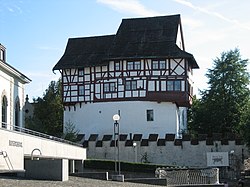
Zug is the largest town and capital of the Swiss canton of Zug in Switzerland. Its name originates from the fishing vocabulary; in the Middle Ages it referred to the right to pull up fishing nets and hence to the right to fish.

The canton of Bern or Berne is one of the 26 cantons forming the Swiss Confederation. Its capital city, Bern, is also the de facto capital of Switzerland. The bear is the heraldic symbol of the canton, displayed on a red-yellow background.

Lenzburg Castle is a castle located above the old part of the town of Lenzburg in the Canton of Aargau, Switzerland. It ranks among the oldest and most important of Switzerland. The castle stands on the almost circular castle hill, which rises approximately 100 m (330 ft) over the surrounding plain but is only about 250 m (820 ft) in diameter. The oldest parts of the castle date to the 11th century, when the Counts of Lenzburg built it as their seat. The castle, its historical museum and the castle hill with its Neolithic burial grounds are listed as heritage sites of national significance.
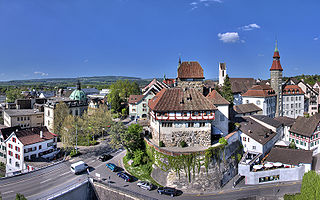
Frauenfeld is the capital of the canton of Thurgau in Switzerland.

Nidau is a municipality in the Biel/Bienne administrative district in the canton of Bern in Switzerland.

The Castles of Bellinzona are a group of fortifications located around the town of Bellinzona, the capital of the Swiss canton of Ticino. Situated on the Alpine foothills, the group is composed of fortified walls and three castles named Castelgrande, Montebello and Sasso Corbaro. Castelgrande is located on a rocky peak overlooking the valley, with a series of walls that protect the old city and connect to Montebello. Sasso Corbaro, the highest of the three castles, is located on an isolated rocky promontory south-east of the other two. The Castles of Bellinzona with their defensive walls have been an UNESCO World Heritage Site since 2000.
The Kyburg family was a noble family of grafen (counts) in the Duchy of Swabia, a cadet line of the counts of Dillingen, who in the late 12th and early 13th centuries ruled the County of Kyburg, corresponding to much of what is now Northeastern Switzerland.
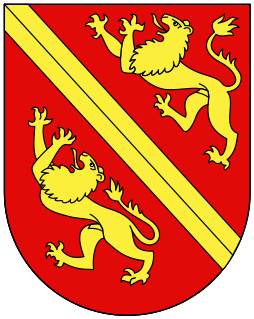
The Burgdorferkrieg or Kyburgerkrieg was a war in 1383-84 between the counts of Neu-Kyburg and the city of Bern for supremacy in the County of Burgundy in what is now Switzerland.

Burgdorf Castle is a castle in the municipality of Burgdorf in the canton of Bern in Switzerland. It is a Swiss heritage site of national significance.

Nidau Castle is a castle in the municipality of Nidau of the Canton of Bern in Switzerland. It is a Swiss heritage site of national significance.

Oberhofen Castle is a castle in the municipality of Oberhofen of the Canton of Bern in Switzerland. It is a Swiss heritage site of national significance.

Spiez Castle is a castle in the municipality of Spiez of the Swiss canton of Bern. It is a Swiss heritage site of national significance.
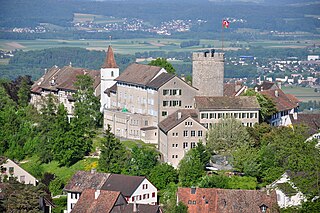
Regensberg Castle is a hill castle which was built about the mid-13th century AD by the House of Regensberg in the Swiss municipality of Regensberg in the Canton of Zürich.
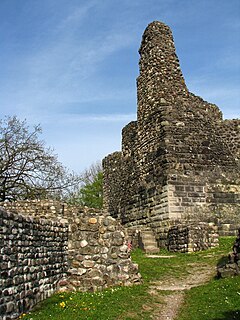
Alt-Regensberg Castle is a hill castle which was built about the mid-11th century AD by the House of Regensberg in the Swiss municipality of Regensdorf in the Canton of Zürich.

Wiedlisbach Castle is a former tower house and defensive tower in the municipality of Wiedlisbach of the Canton of Bern in Switzerland.
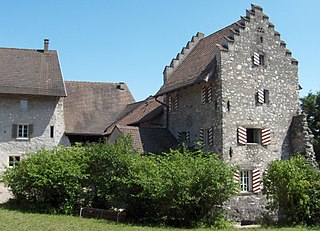
Altenburg Castle is a castle in the village of Altenburg bei Brugg in the municipality of Brugg in the canton of Aargau in Switzerland. The castle and the Altenburg Roman ruins, which are integrated into it, are classified as Swiss heritage site of national significance.

Trostburg Castle is a small castle in the municipality of Teufenthal in the canton of Aargau in Switzerland.

Landenberg Castle is a ruined castle atop a hill in the municipality of Sarnen in the canton of Obwalden in Switzerland. In the 18th century an armory and firing range were built on the site. The Landenberg Armory is a Swiss heritage site of national significance. The ruins of the castle was the meeting place of the Landsgemeinde or Cantonal assembly for over three centuries.
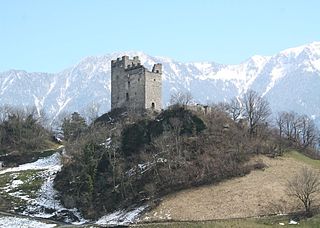
Wartau Castle is a ruined castle in the municipality of Wartau of the Canton of St. Gallen in Switzerland. It is a Swiss heritage site of national significance.

The Vorburg is a ruined castle located in the village of Oberurnen, now part of the municipality of Glarus Nord in the Canton of Glarus of Switzerland. It is the most significant castle in the canton.
